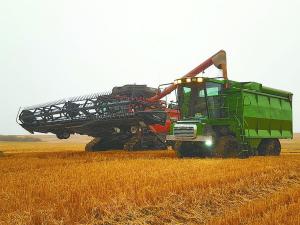2017 - Volume #41, Issue #1, Page #02
[ Sample Stories From This Issue | List of All Stories In This Issue | Print this story
| Read this issue]
Self-Propelled Grain Cart Made From Airport Pumper
 |
Thanks to a bit of imagination and strong mechanical skills, the St. Albert, Alberta area father-son duo modified and re-purposed an airport foam pumper they came across at an auction sale, turning it into a self-propelled unit that can maneuver quickly in the field.
They spent a winter working on the conversion, investing around $90,000 worth of labor and materials.
“The pumper had a 430-hp Detroit engine with a 6-speed automatic transmission with full-time 4-WD,” Shane explains. “We stripped the complete body off of it, built a 900-bu. hopper-bottom grain box with augers, and replaced the original cab with one from a 2380 Case combine, which we sandblasted and painted green. We raised it up high enough so we’d be able to look into the grain trailers when unloading into them.”
The box is 10 ft. wide by 20 ft. long by 10 ft. deep and its hydraulic auger system consists of an 8-in. dia drag auger, which feeds into a salvaged 9720 White combine’s unloading auger assembly (which they shortened to 15 ft. of swing). In hindsight, Schafers says he wishes the 14-in. dia. top auger was bigger.
“The motor sits at the back, underneath where the grain tank hopper slopes up, so you don’t hear any engine noise at all in the cab,” he says. “We mounted a 100-gal. fuel tank and a 50-gal hydraulic tank in the front, and they’re covered by a Freightliner grill that someone gave us. The bumper is from the original foam machine. We put 33-in. wide floater tires on it so we can play in the mud – this fall was extremely wet, and it would go through places where the combine normally couldn’t.”
The Schafers built the rig so that it could also be transformed into a self-propelled sprayer. They simply replace the grain box with an old, pull-type, 120-ft. boom sprayer they had modified to mount in its place during spraying season.
“It does 50 mph on the highway, which comes in handy when moving between fields,” he says. “We did spend the first 4 or 5 years fine tuning the hydraulics, and overall, we probably didn’t save any money. Still, it has a lot of great features and we have the satisfaction of having made it ourselves. It’s certainly unique-looking, too.”
Contact: FARM SHOW Followup, Shane Schafers, St. Albert, Alberta Canada (schafers@hotmail.com).

Click here to download page story appeared in.

Click here to read entire issue




